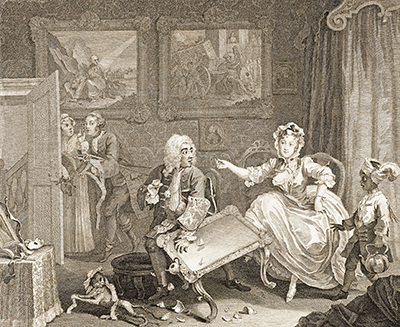Moll is now a kept woman, the mistress of a wealthy merchant is the title of Plate 2 of the 1732 original engravings from A Harlot's Progress, a series of six paintings completed in 1731 (destroyed in a fire of 1755).
The artist was the celebrated Englishman, William Hogarth (Fellow of the Royal Society of Arts), 1697-1764, who also practised as a printmaker, pictorial satirist, social commentator and editorial cartoonist. A Harlot's Progress was a very popular comic strip-like sequence that included modern moral subjects. Hogarth sold 1,240 sets of six prints. Its title and intense allegorical nature were strongly influenced by John Bunyan's Pilgrim's Progress.
The main protagonist of this scene is a tragic young woman named Moll Hackabout (see the coffin-lid in Plate 6) who, after her arrival in Cheapside, London from the countryside has been duped into prostitution. The other leading character is a wealthy Jewish merchant (see the Old Testament paintings in the background that confirm his religion). The mahogany table and various tea-related objects suggest his money has been made by trade from the British colonies.
Moll's previous innocence and naiveté are now very much character traits of her past. Her dress is no longer modest and she now has the company of a West Indian serving-boy, a young female servant and an entertaining pet monkey, all lavish gifts from her doting master. In addition, Moll owns jars of cosmetics and a mask for depraved masquerades. She deliberately pushes over a table to distract attention as a second, secret lover very furtively exits the room.
The left painting, "Jonah outside Nineveh", depicts Jonah beseeching the city's inhabitants to mend their sinful ways, and simultaneously acts as a metaphorical warning to Moll. The right one, "David dancing before the Ark while Uzzah is knifed in the back" also refers to Moll's evil acts and portends her death. It is very evident from Hogarth's many clues that Moll is now sexually promiscuous and in a process of steep moral decline. In Plate 3, she appears further debased as a common prostitute. In 1997, Elizabeth Einberg very aptly refers to the artist's "wry, satirical perception of the human condition" in the London Tate Gallery exhibition catalogue, "Hogarth the Painter".




